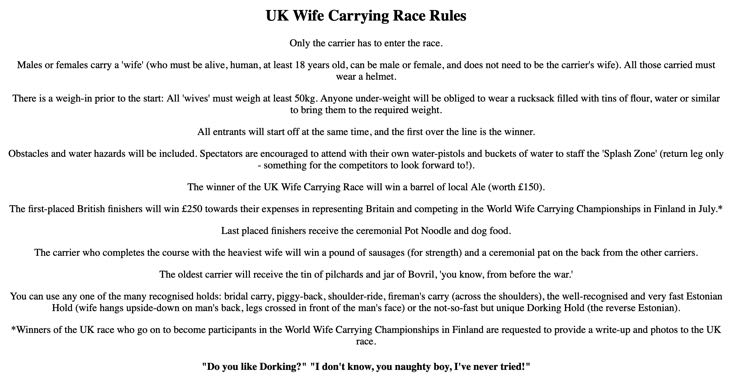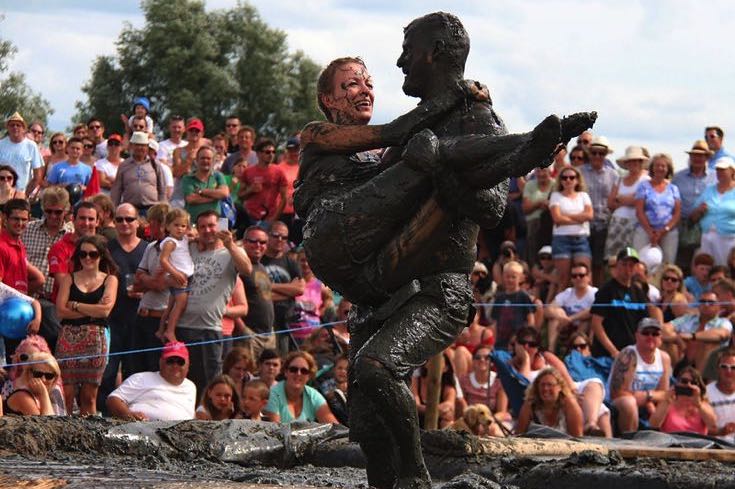In the vast majority of heterosexual relationships it is the wife that carries the husband, in a metaphorical sense at least. The saying ‘behind every successful man there is a great woman’ sums that up; although the notion that the woman is there to look after the household is long gone. Even so, there are plenty of old traditions that live on well past their sell-by-date, which is why the Wife Carrying World Championship remains a thing that people not only love to get involved in but also head along to watch. Interestingly, though, the woman being carried doesn’t need to be the carrier’s actual wife.
The Origins of the Wife Carrying World Championship
 The tradition of wife carrying began in Finland, where the activity is referred to as Eukonkanto. One of the stories about the origins of wife carrying tells the story of Herkko Rosvo-Ronkainen, or Ronkainen the Robber, who was believed to live in a forest in the late 1800s. He would run around with a gang of fellow thieves, causing problems for villagers in the local area. From there, there are three possible reasons behind the origins of wife carrying. The first says that Rosvo-Ronkainen and his not-so-merry men were accused of stealing food and abducting women from the villages in the local area that they went about ransacking.
The tradition of wife carrying began in Finland, where the activity is referred to as Eukonkanto. One of the stories about the origins of wife carrying tells the story of Herkko Rosvo-Ronkainen, or Ronkainen the Robber, who was believed to live in a forest in the late 1800s. He would run around with a gang of fellow thieves, causing problems for villagers in the local area. From there, there are three possible reasons behind the origins of wife carrying. The first says that Rosvo-Ronkainen and his not-so-merry men were accused of stealing food and abducting women from the villages in the local area that they went about ransacking.
That story saw them carry the women on their backs as they ran away, which is how the notion of wife carrying developed. Another story says that young men at the time would head to neighbouring areas and abduct women that they would force to marry them, even if the women were already married. The women were, once again, carried on the backs of the men that were stealing them. The final idea is that Rosvo-Ronkainen trained his fellow thieves to become faster and stronger by carrying sacks on their back that were filled with various weights, with the women coming along later as part of a silly tradition.
The Wife Carrying World Championships began in Sonkajärvi, Finland in 1992, with the prize on offer to the winner being their wife’s weight in beer. The Sonkajärvi Wife Carrying Limited owns the Trade Mark of ‘Wife Carrying’, as well as Eukonkanto in Finnish, with global partners springing up around the world. They are then able to hold their own licensed Wife Carrying Competitions. There has been an Australian Wife Carrying Championship since 2005, for example, whilst the United Kingdom Wife Carrying Race began three years later with the spurious claim that it had been established ‘around 1,200 years ago’.
What Are the Rules?

The original course on which the Wife Carrying World Championship took place was one that boasted rocky terrain, fences and brooks that the wife-carrier needed to content with. Over the years, however, it has been changed and altered to be less rough and more in keeping with the modern world. Instead of full rocks that people need to climb over there is sand, for example. There are still fences and there is usually some sort of area that is filled with water, but it is obviously more readily set up in an artificial manner than it used to be. The key to the entire thing is that competitors have fun, even if it is taken very seriously.
Competitors run over a track that is 253.5 metres in length, or 832 feet. As well as two dry obstacles, the water obstacle needs to be around one metre deep. The wife can be your actual wife, the wife of a ‘neighbour’ or a ‘wife’ found from further afield, but they do need to be over 17 years of age with a minimum weight of 49 kilograms, which is around 108 pounds. The wife can technically weigh less than that, but they will be burdened with a rucksack that has enough weight to bring the overall carry-package to the desired weight. The only specific equipment that is used is a helmet for the carried person and a belt for the carrier.
In 2023, the rules were adapted in order to reflect that ‘wife’ is a gender-free term that is used for the carried person. The overall winner of the Wife Carrying World Championship is the person that completes the course in the fastest time. There are prizes awarded for best costume, most entertaining couple and the person who carried the heaviest weight. When the contestants take part in the race, they do so in sets of two couples at a team, meaning that each race is its own contest. The contestants are responsible for taking care of their own safety and any insurance that it is deemed that they need to take out beforehand.
How Quickly Do the Winners Run?
You might well be wondering about the level of competition that you would be up against, should you choose to take part in the Wife Carrying World Championship. Here is a look at the winners over a ten year period to give you a sense of just how quickly the winners tend to complete the course:
- 2023 – 66.4 seconds (Taisto Miettinen and Katja Kovanen)
- 2022 – 67.4 seconds (Taisto Miettinen and Katja Kovanen)
- 2019 – 66.7 seconds (Vytautas Kirkliauskas and Neringa Kirkliauskiene)
- 2018 – 65.1 seconds (Vytautas Kirkliauskas and Neringa Kirkliauskiene)
- 2017 – 68.6 seconds (Taisto Miettinen and Kristiina Haapanen)
- 2016 – 62.7 seconds (Dmitry Sagal and Anastasia Loginova)
- 2015 – 62.7 seconds (Ville Parviainen and Sari Viljanen)
- 2014 – 63.7 seconds (Ville Parviainen and Janette Oksman)
- 2013 – 65.0 seconds (Taisto Miettinen and Kristiina Haapanen)
- 2012 – 61.2 seconds (Taisto Miettinen and Kristiina Haapanen)
Between 1997 and 2023, the quickest time that the winners managed to complete the circuit in was 55.5 seconds, achieved by Margo Uusorg and Birgit Ulrich, both from Estonia, back in 2000. On the flip side, the longest time that the winners have made it home in is 69.2 seconds, managed by Jouni Jussila and Tiina Jussila from Finland, which happened in 1997. During that same time period, the winners came from Finland, Estonia, Russia and Lithuania. Margo Uusorg won it seven times with different partners, whilst Taisto Miettinen won it eight times, also with different ‘wives’, including five successive wins with Kristiina Haapanen.
It’s as Fun to Watch as Take Part in
Whilst it might not seem like the Wife Carrying World Championship is the best competition in the entire world in terms of equality and taking on the patriarchy, there is actually plenty to enjoy about it from a spectator’s point of view. Whilst the actual wife carrying itself is lots of fun to watch, not least of all thanks to the different ways in which people try to carry their ‘wives’, there is also the likes of karaoke competitions on the go to keep every in the party mood. Competitors are paraded to the starting line with flags and fanfare, all whilst officials in costumes move around and ensure that everything is running smoothly.
You will be entertained throughout the races themselves by a commentary, plus there are races other than just the wife carrying taking place. There is, for example, a relay race in which three men take part, using the ‘wife’ as the equivalent of a baton that has to be passed back and forth. The overall Wife Carrying World Championship sees people from all over the world taking part, including former Olympic athletes as well as just random people looking to tick something off the bucket list. You have to pay to get in, but the views are pretty good from the seating area, where you can watch the wife carrying, karaoke and the tractor parade.

